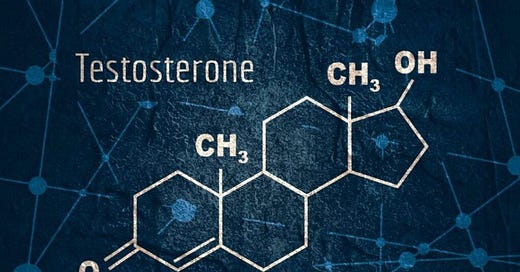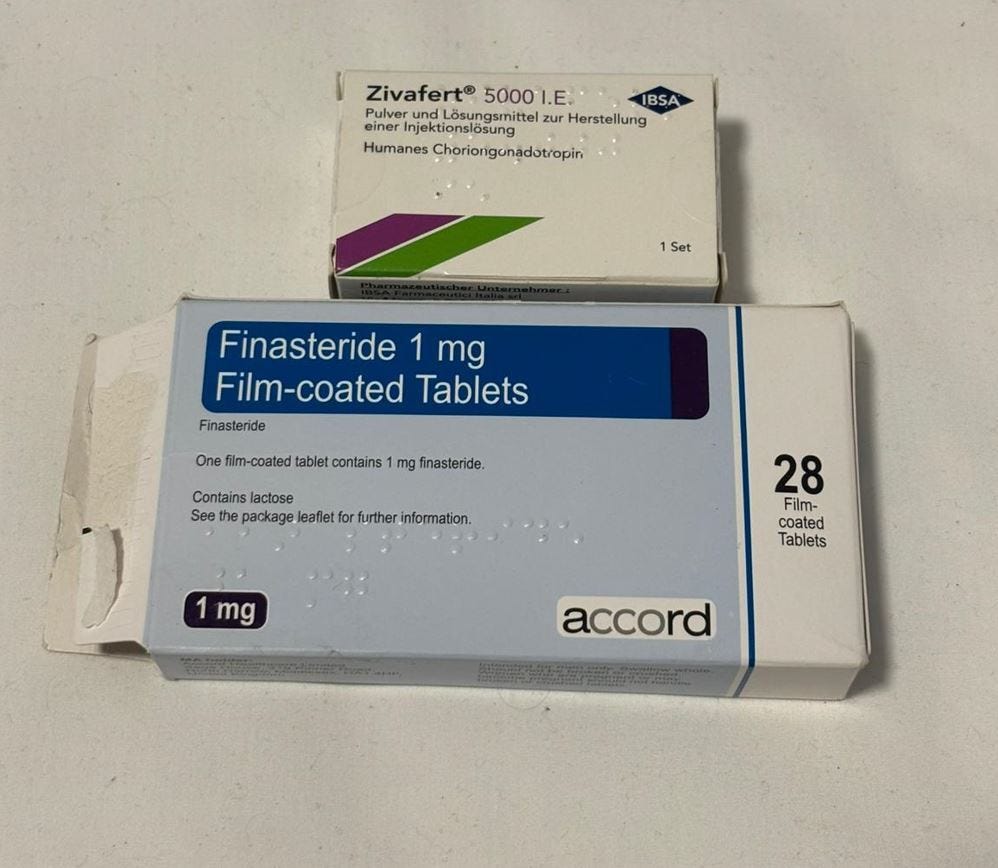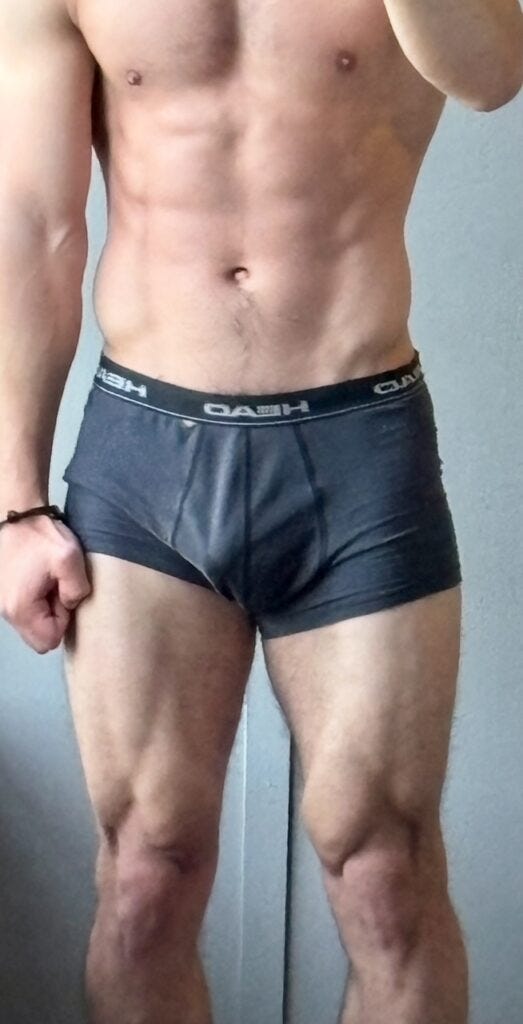“TRT lite” – The Best of Both Worlds
My experience with my specific testosterone replacement protocol
I very much liked some of the benefits of my recent TRT experiment (discussed in more detail here), particularly the behavioral effects. However, I disliked the virilizing effects, which are also pro-aging effects.
Goals
Elevate levels of testosterone and get many of the associated benefits (energy, dominance-behavior, muscle growth) without the virilization (e.g., increased hair growth, male pattern baldness) and rapid visual aging (e.g., changes in dermal elastin content, being much older looking than biological age) usually associated with TRT
Elevate my levels of estradiol, which are always on the lower side – presumably because I carry little body fat, which expresses aromatase. Estradiol is particularly important for energy levels, mood, libido, and cognition.
My reproductive axis not being shut down.
Protocol
After playing around with different variables for a little bit, I found a regimen that, for me, achieves all these goals.
The regimen is simple:
100 IU hCG per day. This dose is considerably lower than the average hCG dose. In my opinion, most people use far too much – particularly young people with healthy testes.
0.125mg finasteride per day
Because hCG stimulates intratesticular aromatization it is known to elevate levels of E2 disproportionately, which for me is a plus because my E2 levels are on the lower site. Fun fact, after about 10 weeks of pregnancy a female body produces about 500.000-200.000 IU of HCG per day, I am using about 0.5% of that. Most of the HCG available in the pharmacy is HCG derived from the urine of pregnant women.
While the addition of finasteride may reduce some of the testosterone-associated mental benefits, I find that, for me, it does not reduce them at all. I have now been on it for about 1 year and have zero side effects (as far as I can tell). Furthermore, the benefits that are due to an increased level of estradiol remain untouched. If I had to choose, I would happily trade in some of my DHT for increased E2.
Disclaimer: Finasteride is a potentially risky business. I know about half a dozen people on finasteride and, other than the beginning, nobody noticed any side effects. However, anecdotally, for some men, finasteride has a lot of downsides, including depression (and rare reports of suicidal ideation), brain fog, and libido issues. Furthermore, there is a risk of post-finasteride syndrome – though the risk is probably much smaller than what online communities make it out to be as most people who have no side effects on the drug just move on with their lives and do not write about it. In other words, the internet is a magnifying glass for the people who have a negative experience with a drug. Anyway, I used a specific strategy to lower the risk of PFS occurring – outlined in the article.
Blood levels after 4 months on this protocol:
Testosterone: 910ng/dl (range: 350-826) (Note: On hCG my levels are less subject to the natural circadian variation essentially raising my AUC-levels of testosterone more than what the snapshot by a blood test would predict.)
Bioavailable testosterone: 4.83 ng/ml (range: 1.260-4.110)
SHBG: 36 (range: 16-60)
Estradiol: 33pg/ml (27-52)
LH: 1.2 mU/ml (range: 1.7-8.6)
Blood levels after 8 months on this protocol:
Testosterone: 1090ng/dl (range: 350-826)
Bioavailable testosterone: 4.83 ng/ml (range: 1.260-4.110)
SHBG: 31 (range: 16-60)
Estradiol: 42pg/ml (27-52)
LH: 1.21 mU/ml (range: 1.7-8.6)
I was actually surprised that my free testosterone is above the reference range while I am not even shut down. The fact that my HPTA is not shut down (while my testicles are stimulated by the hCG) means that it would probably take me only a couple of days to recover my baseline HPTA function should I ever want to come off – and without harsh PCT drugs.
Scientific background
The anabolic-androgenic ratio is the ability of an androgen to provide anabolism (essentially muscle growth) vs. virilization (e.g., body hair growth, beard growth, oily skin, the growth of androgenic tissues such as penis and larynx during puberty, etc.). Different androgens have different anabolic-androgenic ratios. For example, oxandrolone (Anavar) has a phenomenal anabolic-androgenic ratio of roughly 7:1, meaning that molecule for molecule, oxandrolone is 7x more anabolic than it is androgenic. Hence it is frequently used by women as their preferred anabolic steroid.
By default, testosterone itself has an anabolic-androgenic ratio of 1:1 and DHT has roughly an anabolic-androgenic ratio of about 1:5. When it comes to testosterone itself (in the presence of a 5a-Reductase inhibitor which prevents its conversion to DHT), testosterone itself is quite balanced but DHT itself is mostly androgenic and weakly anabolic.
The reason why DHT is highly androgenic is its high affinity for the androgen receptor. But why doesn’t a high affinity for the AR also result in high anabolic activity? Yes, it should but it turns out that muscle tissue expresses an enzyme (3-hydroxysteroid dehydrogenase) that breaks down DHT before it can exert its effects. As a side note, oxandrolone is basically pure DHT but modified in a way that 3HSD cannot break it down thus making it capable of exerting its full effects in muscle tissue.
The androgenicity of DHT is evident in individuals with mutations in 5aR-enzymes. They have normal testosterone levels but low DHT levels. They look mostly like men (incl. muscle growth, bone structure) but they are poorly virilized (e.g., micropenis, little body hair).
After adulthood is reached and virilization is mostly completed (e.g., voice changes, penis size, hair follicle maturation), in my opinion, DHT does more harm than good if testosterone levels are otherwise high. The high levels of testosterone are sufficient to compensate for a reduction in DHT levels (which would e.g., affect libido, “feeling like a man”, androgenic behaviors). DHT also leads to male pattern baldness, oily skin, prostate growth, lots of body hair growth, and a fast-aging phenotype. Some characteristics (such as sex drive, motivation, and cognition) are served by both T and DHT and either high T or normal DHT would be enough by themselves to activate these traits.
Therefore, after virilization is mostly completed, in my opinion, the ideal phenotype is having high levels of testosterone but low levels of DHT. The high levels of testosterone give many of the good aspects that are associated with T (e.g., libido, drive, muscle mass, bone, fat loss) but by preventing its conversion into DHT one does not get most of the bad stuff (e.g., hair growing in places you did not even know could grow hair, prostate growth, excessive libido). Sure, some “gains” in terms of libido, aggression, and dominance behavior may be left on the table but, in my opinion, too much of these is a bad thing anyway.
Obviously, messing with DHT is more dangerous if total T levels are low. The reason for the evolution of the DHT-mechanism is to be a tissue-specific amplifier of androgen levels. If total T levels are low, DHT can still amplify androgen action locally (e.g., very important in the womb, childhood, and adolescence). In other words, if T levels are low, one “needs” the DHT to compensate for the low T in specific tissues so that still enough androgen signaling is present. Conversely, if T levels are high, one does not need the DHT because the testosterone itself can fulfill many of the DHT roles.
So, knowing all of this, one can calculate the anabolic vs androgenic properties of my protocol:
Testosterone has an anabolic-androgenic ratio of 1:1. DHT has an anabolic-androgenic ratio of about 1:5 and some people even say 1:10 (meaning that DHT is much more androgenic than testosterone). Furthermore, plasmatic levels of DHT do not tell the whole story because much of the local amplification of T into DHT (e.g., in the hair follicles and prostate) is not reflected by plasmatic levels. In these “androgenic” tissues, levels of DHT often exceed levels of testosterone, meaning that while in the plasma about 1 out of 10 testosterone molecules is DHT, locally, often DHT molecules outnumber testosterone molecules. In fact, some studies show that in the skin and scalp DHT levels outnumber testosterone levels by 10:1 (vs. 1:10 in the plasma). Consequently, finasteride has an outsized impact on androgenic tissues that is not picked up by a normal blood test.
So, how androgenic vs anabolic is my protocol?
My normal testosterone levels are roughly 600-700ng/dl in the morning. In the afternoon they are about 400ng/dl, leading to a daily average levels of about 550ng/dl. At this level, my DHT levels would be roughly at 50-60ng/dl (about 10% of total). So, if my natural state is my default state (100% anabolic and 100% androgenic as a reference), then on my TRT lite protocol (total T at around 1000ng/dl with less fluctuations; DHT of around 100ng/dl but reduced by 70% due to the finasteride), my total androgenic load would come out as around 80-90% of my natural state (purely judged from plasma levels) and my total anabolic load would be 150-180% of my natural state. In other words, my total androgenic load is overall lower than my baseline whereas I benefit significantly from the benefits of increased testosterone levels.
However, this calculation was done using plasma levels. In reality, plasma DHT levels do not fully capture tissue-specific androgenic activity, which, as mentioned, often deviates a lot from plasmatic levels. Accounting for tissue-specific DHT amplification the overall androgenic burden in DHT-sensitive tissues is likely reduced by much more than what plasma levels capture. If I had to guess, my androgenic state is roughly 60-70% of my baseline state instead of the 80-90% calculated above.
Hence, in theory, my protocol shifts the balance in favor of the “good” sides of TRT (e.g., muscle growth, emotionality, libido) which are mediated by testosterone and estradiol. Conversely, the “bad” sides of TRT (e.g., hair loss, oily skin, body hair growth, fast-aging phenotype, excessive libido, excessive dominance behavior) are reduced.
One has to keep in mind that roughly 50% of the benefits of my TRT protocol are not due to testosterone but rather due to the higher levels of estradiol, which I did not even discuss in the paragraphs above.
Changes I noticed
It seems that many people partially hop on TRT mostly because they want to look better. However, a couple of years down the line, many people look much worse and older. While not as potent as the proper TRT I did before, I feel that this “TRT lite” gives me many of the benefits without the downside of virilization and quickly making me look much older.
My baseline energy levels are definitely higher.
My favorite change is that I now feel more deeply and I am moved to tears quite often. It is fascinating how emotional intensity can be changed by changing hormones.
Unlike with the proper TRT I did before, I am not sure whether my dominance behavior has changed much, which may either be due to the honeymoon phase being over, it being so subtle that I do not notice, or because the addition of finasteride cancels out the effects of increased testosterone levels. For some time I used a microdose of rasagiline to counteract the finasteride-induced depletion of dopamine synthesis in the ventral tegmentum, a site rich in androgen receptor expression but I recently came off that.
My body odor returned to “normal” – presumably due to the finasteride.
My libido is much higher than before to the point of it sometimes being distracting. As far as I can tell, finasteride has not affected my libido.
As I started the finasteride, I had weak erections for 1 week (though my libido was unaffected). After the first and second dosage increases, I also noticed puffy nipples, which I managed effectively with a self-made topical cream containing the weakly androgenic DHT-derivative oxandrolone (explained here). A DHT-blood test (which oxandrolone would cross-react with as it is a DHT derivative) has shown that there is no systemic absorption. The puffy nipples would have probably gone away on their own eventually. Gynecomastia is a rare side effect of finasteride.
Despite the finasteride (which I started at only 0.03mg per day for the first 3 months) I noticed a slight increase in body hair growth. Therefore, I doubled my finasteride dosage after 3 months to 0.06mg per day and I doubled my dose again 6 months, and then after 6 months I doubled it again reaching a final dosage of 0.25mg. I barely had any side effects and the hair that had grown on TRT has actively regressed. In other words, while body hair spiked after my TRT experiment, it decreased again after adding the finasteride. I have now about the same amount of body hair on HCG + finasteride as I did before my 2nd run with TRT.
I gained about 6kg of weight, which I guess is equally split between water retention, muscle mass, and fat.
Looks are perhaps the third reason why I do this (after energy levels and emotional changes) but people always seem to be the most interested in looks. 9 months after starting my TRT Lite protocol. Before, I looked good without a shirt but like a “normal guy” when I wore shirts. Now I also look quite musled in shirts and I get frequent comments about it. I particularly like the fact that my body hair has barely changed – mostly due to the finasteride.
Overall, I have been on my TRT lite protocol now for a little over a year. I can safely say that increasing my levels of testosterone & estradiol has increased my quality of life and probably also my health, presumably mostly because it lifted me from a “low E2 state” into a “decent E2 state”. While it is not “life-changing” by any means, overall I feel it to be quite a strong net benefit to multiple aspects of my life.
Given that I am not shut down (neither my hypothalamus-pituitary nor my testicles) and given that I prevent most of the irreversible virilization and rapid visual aging by the addition of a low dose of finasteride, I can easily come off anytime without having regrets about having done irreversible damage to the way I look (my looks are tied to my self-esteem more than I would like and therefore I would hate myself for wrecking them).
I will try to keep this article updated. Sign up for my newsletter to get notified about changes in thinking and updates.
It is not just me!
I recently had a patient who “felt like shit” all the time. Among other things, his T was borderline low. I put him on 100 IU HcG per day, and despite being in his 40s, 3 months later, his T was around 900 and his E2 perfectly in the middle of the reference range. He now feels “like shit” much less, though T was not his only issue. Another friend of mine is on just 50IU HCG per day and feels very good on it.
My friends and I use 1500 IU vials of HCG we mix with bacteriostatic water. I usually put the vial beneath an egg cup in my fridge to protect it from light.
The upside of HCG is that at these dosages, most people will not be suppressed, which means that they can come off any time and should bounce back to baseline within a week or so (given that their HTPA is not fully shut down – i.e., LH/FSH unmeasurable). Furthermore, at these dosages, there is no Leydig cell hyperstimulation.
Another upside of HCG is that it stimulates adrenal steroidogenesis and “backfills” some of the other hormonal pathways.
Many people complain that HCG raises their E2 too much, but in my opinion, this is mostly because most people use too high of a dosage and too low of a frequency (e.g., 250IU twice per week). HCG does elevate E2 disproportionately, particularly due to intratesticular aromatization, but again, this is dosage-dependent. 100 IU once per day raises E2 less than 350 IU twice per week, despite being the same weekly dosage.
In my opinion, daily low-dose HCG should be first-line therapy for low testosterone, and only if there is an inadequate response should people move on to injectable testosterone. Just as with other treatments, obviously, there will be people for whom HCG does not work for a number of reasons. Nonetheless, in my opinion, it is the lowest-risk testosterone replacement option out there, and for some, probably also the best.
The major downside with HCG is that its effectiveness depends on your Leydig cell function and at normal dosages (75IU – 150IU daily) it barely raises T levels above 1000ng/dl.
Lesson: By doing daily injections, one can do a “TRT lite” without being shut down. Not being shut down makes coming off a non-issue as LH and FSH will be back to their normal levels within maybe a week or so.
Conversely, the longer (and harder) one is shut down (e.g., by using more suppressive androgens and/or higher dosages), the greater the risk of having issues with recovering properly, presumably due to epigenetic modifications in hypothalamic neurons.
My experience in more detail: My TRT Lite Protocol







